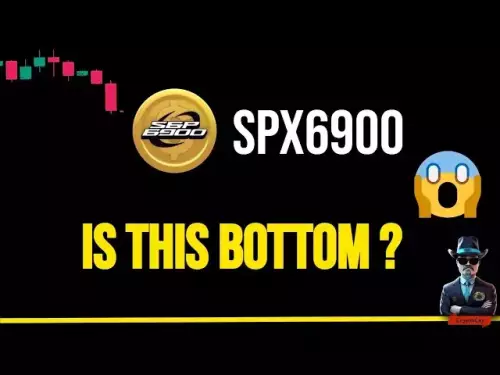-
 Bitcoin
Bitcoin $113100
-1.74% -
 Ethereum
Ethereum $4800
1.16% -
 XRP
XRP $3.041
0.36% -
 Tether USDt
Tether USDt $0.9999
0.02% -
 BNB
BNB $876.6
-0.40% -
 Solana
Solana $205.1
0.96% -
 USDC
USDC $0.0000
0.00% -
 Dogecoin
Dogecoin $0.2345
-0.10% -
 TRON
TRON $0.3629
0.40% -
 Cardano
Cardano $0.9260
1.91% -
 Chainlink
Chainlink $26.20
0.28% -
 Hyperliquid
Hyperliquid $46.04
2.89% -
 Sui
Sui $3.722
0.22% -
 Stellar
Stellar $0.4113
-0.53% -
 Ethena USDe
Ethena USDe $1.000
0.03% -
 Bitcoin Cash
Bitcoin Cash $590.3
0.39% -
 Avalanche
Avalanche $25.82
-0.01% -
 Hedera
Hedera $0.2504
-0.92% -
 Litecoin
Litecoin $119.1
-1.33% -
 UNUS SED LEO
UNUS SED LEO $9.598
0.03% -
 Toncoin
Toncoin $3.315
-1.69% -
 Shiba Inu
Shiba Inu $0.00001308
-1.02% -
 Uniswap
Uniswap $11.06
-2.10% -
 Polkadot
Polkadot $4.149
-1.10% -
 Dai
Dai $1.000
0.03% -
 Aave
Aave $350.7
-1.07% -
 Cronos
Cronos $0.1587
0.97% -
 Bitget Token
Bitget Token $4.664
-0.71% -
 Monero
Monero $274.5
3.42% -
 Ethena
Ethena $0.7021
-4.70%
How to read the BOLL closing and opening? What do these two patterns indicate?
Bollinger Bands help crypto traders assess volatility and trends; closing above the upper band may signal overbought conditions, while below the lower band suggests oversold.
May 25, 2025 at 09:56 pm

The Bollinger Bands (BOLL) are a popular technical analysis tool used by cryptocurrency traders to assess market volatility and identify potential price trends. Understanding how to read the BOLL closing and opening patterns can significantly enhance a trader's ability to make informed decisions. This article will delve into the specifics of interpreting these patterns and what they indicate in the context of cryptocurrency trading.
Understanding Bollinger Bands
Bollinger Bands consist of three lines: the middle band, which is typically a simple moving average (SMA), and two outer bands that are standard deviations away from the middle band. The standard setting for Bollinger Bands is a 20-day SMA for the middle band and two standard deviations for the upper and lower bands. These bands expand and contract based on market volatility, providing visual cues about potential price movements.
Reading BOLL Closing Patterns
BOLL closing patterns refer to the position of the closing price of a cryptocurrency in relation to the Bollinger Bands at the end of a trading period. These patterns can help traders identify potential reversals or continuations in the market.
Closing Above the Upper Band: When the closing price of a cryptocurrency ends above the upper Bollinger Band, it often indicates that the market might be overbought. This could signal an impending price correction or a potential reversal to the downside. Traders might consider this a signal to take profits or initiate short positions.
Closing Below the Lower Band: Conversely, if the closing price falls below the lower Bollinger Band, it suggests that the market could be oversold. This might indicate an upcoming price rebound or a reversal to the upside. Traders may view this as an opportunity to buy the dip or initiate long positions.
Closing Within the Bands: When the closing price remains within the Bollinger Bands, it generally indicates a period of consolidation or a lack of strong directional momentum. Traders might interpret this as a signal to wait for more definitive signals before making trading decisions.
Reading BOLL Opening Patterns
BOLL opening patterns involve the position of the opening price of a cryptocurrency in relation to the Bollinger Bands at the start of a trading period. These patterns can provide insights into potential price movements for the day.
Opening Above the Upper Band: If the opening price starts above the upper Bollinger Band, it could suggest that the market opened with strong bullish momentum. Traders might see this as a continuation signal, expecting the price to rise further. However, it could also indicate that the market is overbought, and a pullback might be imminent.
Opening Below the Lower Band: An opening price below the lower Bollinger Band may indicate strong bearish momentum at the start of the trading period. Traders could interpret this as a signal for potential further declines. Alternatively, it might suggest that the market is oversold, and a price recovery could be on the horizon.
Opening Within the Bands: When the opening price is within the Bollinger Bands, it typically signifies a more balanced start to the trading day. Traders might use this as a signal to monitor other indicators for additional trading cues.
Combining BOLL Closing and Opening Patterns
Combining the analysis of BOLL closing and opening patterns can provide a more comprehensive view of market conditions. For instance, if a cryptocurrency closes above the upper band and opens the next day still above the upper band, it could reinforce the bullish momentum and suggest a strong upward trend. Conversely, if a cryptocurrency closes below the lower band and opens the next day still below the lower band, it might indicate a persistent bearish trend.
Practical Application of BOLL Patterns
To effectively apply BOLL closing and opening patterns in cryptocurrency trading, consider the following steps:
Identify the Bollinger Bands: Plot the Bollinger Bands on your chosen trading platform or charting software. Ensure that the settings are set to the standard 20-day SMA with two standard deviations for the outer bands.
Monitor Closing Prices: At the end of each trading period, note the position of the closing price relative to the Bollinger Bands. Record whether it closed above the upper band, below the lower band, or within the bands.
Observe Opening Prices: At the start of each trading period, check the position of the opening price in relation to the Bollinger Bands. Determine if it opened above the upper band, below the lower band, or within the bands.
Analyze Combined Patterns: Compare the closing and opening patterns to gain insights into potential price movements. For example, a closing price above the upper band followed by an opening price within the bands might suggest a weakening of bullish momentum.
Integrate with Other Indicators: Use BOLL patterns in conjunction with other technical indicators, such as the Relative Strength Index (RSI) or Moving Average Convergence Divergence (MACD), to confirm trading signals and enhance decision-making.
Case Study: Applying BOLL Patterns to Bitcoin
To illustrate the practical application of BOLL closing and opening patterns, let's consider a hypothetical scenario involving Bitcoin (BTC).
Day 1: Bitcoin closes above the upper Bollinger Band, indicating potential overbought conditions. Traders might consider this a signal to take profits or prepare for a potential price correction.
Day 2: Bitcoin opens within the Bollinger Bands, suggesting a more balanced start to the trading day. Traders might interpret this as a sign to monitor other indicators for further signals.
Day 3: Bitcoin closes below the lower Bollinger Band, signaling potential oversold conditions. Traders might view this as an opportunity to buy the dip or initiate long positions.
Day 4: Bitcoin opens below the lower Bollinger Band, indicating persistent bearish momentum. Traders could interpret this as a signal for potential further declines, but also be aware of the possibility of a price recovery due to oversold conditions.
By analyzing these patterns, traders can make more informed decisions about their Bitcoin trades, adjusting their strategies based on the signals provided by the Bollinger Bands.
Frequently Asked Questions
Q1: Can Bollinger Bands be used effectively in highly volatile cryptocurrency markets?
Yes, Bollinger Bands are particularly useful in volatile markets like cryptocurrencies because they adjust dynamically to market conditions. The bands expand during periods of high volatility and contract during periods of low volatility, providing visual cues about potential price movements.
Q2: How often should I adjust the settings of the Bollinger Bands for cryptocurrency trading?
While the standard settings of a 20-day SMA and two standard deviations work well for many traders, you might need to adjust these settings based on the specific cryptocurrency and market conditions. For highly volatile assets, you might consider using shorter periods and wider bands to capture more frequent signals.
Q3: Are there any limitations to using Bollinger Bands for cryptocurrency trading?
Yes, Bollinger Bands are a lagging indicator, meaning they are based on historical data and may not always predict future price movements accurately. Additionally, they should be used in conjunction with other technical indicators to confirm signals and reduce the risk of false positives.
Q4: How can I use Bollinger Bands to identify potential breakouts in the cryptocurrency market?
To identify potential breakouts, look for periods when the price moves outside the Bollinger Bands and then retests the bands without breaking back through them. A breakout above the upper band could signal a bullish breakout, while a breakout below the lower band could indicate a bearish breakout. Always confirm these signals with other indicators for increased reliability.
Disclaimer:info@kdj.com
The information provided is not trading advice. kdj.com does not assume any responsibility for any investments made based on the information provided in this article. Cryptocurrencies are highly volatile and it is highly recommended that you invest with caution after thorough research!
If you believe that the content used on this website infringes your copyright, please contact us immediately (info@kdj.com) and we will delete it promptly.
- Layer Brett: The Dogecoin and Pepe Evolution?
- 2025-08-25 11:05:12
- MOG Digitech, ALT5 Sigma, and Web3 DeFi: Navigating the Future of Finance
- 2025-08-25 10:45:20
- Bitcoin, Corporate Champion, Strategic Buy: Decoding the Trends
- 2025-08-25 11:30:12
- Altcoins Primed for 2025 Bullish Breakouts: Hidden Gems and Market Movers
- 2025-08-25 11:30:12
- LayerZero's Stargate Acquisition: A New Era for Cross-Chain?
- 2025-08-25 12:05:26
- MAGACOIN Finance: Can This Crypto Presale Deliver Explosive Gains?
- 2025-08-25 09:25:14
Related knowledge

What does it mean when the +DI and -DI cross frequently in the DMI indicator but the ADX is flattening?
Aug 11,2025 at 03:15am
Understanding the DMI Indicator ComponentsThe Directional Movement Index (DMI) is a technical analysis tool composed of three lines: the +DI (Positive...

What does the sudden appearance of a "dark cloud cover" candlestick pattern during an uptrend indicate?
Aug 13,2025 at 11:35am
Understanding the 'Dark Cloud Cover' Candlestick PatternThe dark cloud cover is a bearish reversal pattern in technical analysis that typically appear...

What does it mean when the moving average, MACD, and RSI all send buy signals simultaneously?
Aug 11,2025 at 01:42pm
Understanding the Convergence of Technical IndicatorsWhen the moving average, MACD, and RSI all generate buy signals at the same time, traders interpr...

What does it mean when both the KDJ indicator and the RSI show overbought signals simultaneously?
Aug 13,2025 at 11:35am
Understanding the KDJ Indicator in Cryptocurrency TradingThe KDJ indicator is a momentum oscillator derived from the Stochastic Oscillator, widely use...

What does it mean when the price is trading above the SAR indicator but the red dots are densely packed?
Aug 09,2025 at 11:49pm
Understanding the SAR Indicator and Its Visual SignalsThe SAR (Parabolic Stop and Reverse) indicator is a technical analysis tool used primarily to de...

What does it mean when the candlestick chart forms a "Morning Star" but trading volume is sluggish?
Aug 12,2025 at 06:28pm
Understanding the Morning Star Candlestick PatternThe Morning Star is a three-candle bullish reversal pattern commonly observed in cryptocurrency pric...

What does it mean when the +DI and -DI cross frequently in the DMI indicator but the ADX is flattening?
Aug 11,2025 at 03:15am
Understanding the DMI Indicator ComponentsThe Directional Movement Index (DMI) is a technical analysis tool composed of three lines: the +DI (Positive...

What does the sudden appearance of a "dark cloud cover" candlestick pattern during an uptrend indicate?
Aug 13,2025 at 11:35am
Understanding the 'Dark Cloud Cover' Candlestick PatternThe dark cloud cover is a bearish reversal pattern in technical analysis that typically appear...

What does it mean when the moving average, MACD, and RSI all send buy signals simultaneously?
Aug 11,2025 at 01:42pm
Understanding the Convergence of Technical IndicatorsWhen the moving average, MACD, and RSI all generate buy signals at the same time, traders interpr...

What does it mean when both the KDJ indicator and the RSI show overbought signals simultaneously?
Aug 13,2025 at 11:35am
Understanding the KDJ Indicator in Cryptocurrency TradingThe KDJ indicator is a momentum oscillator derived from the Stochastic Oscillator, widely use...

What does it mean when the price is trading above the SAR indicator but the red dots are densely packed?
Aug 09,2025 at 11:49pm
Understanding the SAR Indicator and Its Visual SignalsThe SAR (Parabolic Stop and Reverse) indicator is a technical analysis tool used primarily to de...

What does it mean when the candlestick chart forms a "Morning Star" but trading volume is sluggish?
Aug 12,2025 at 06:28pm
Understanding the Morning Star Candlestick PatternThe Morning Star is a three-candle bullish reversal pattern commonly observed in cryptocurrency pric...
See all articles

























































































